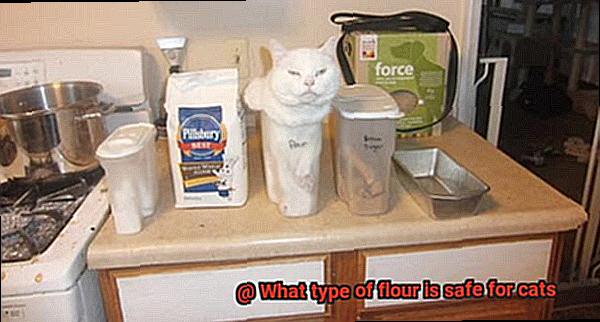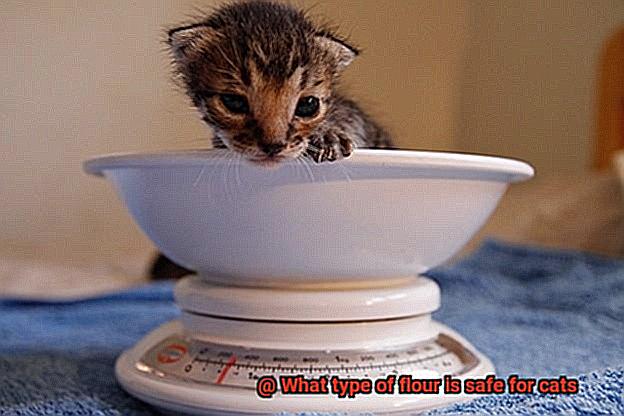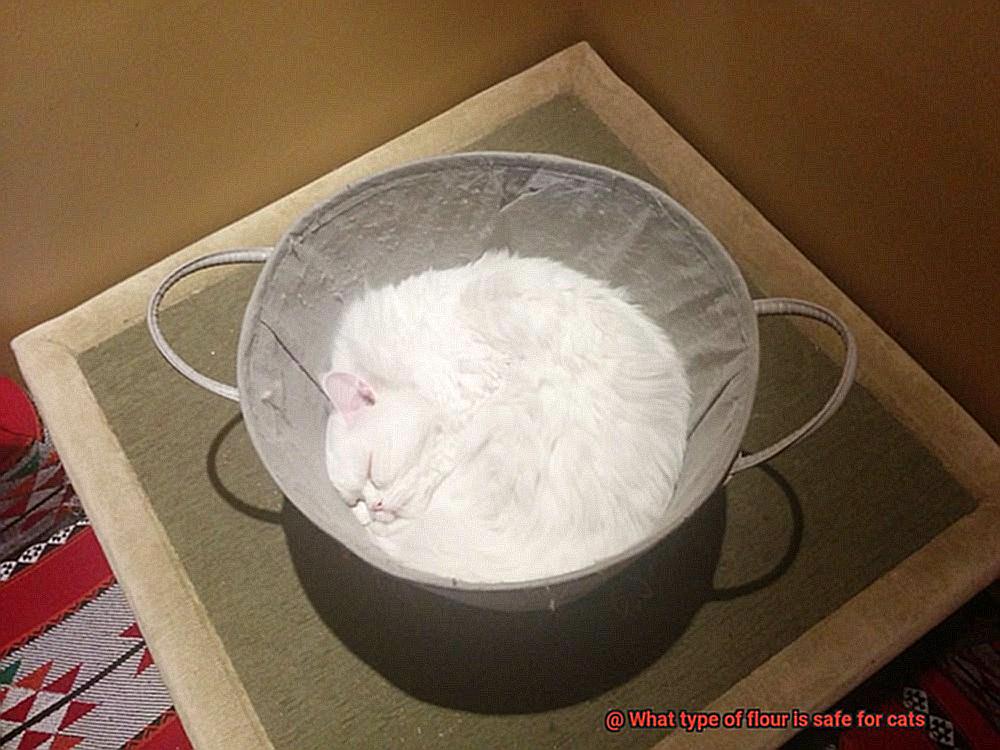As cat owners, we all want to give our furry companions the best possible care and nutrition. However, with so many conflicting opinions and information out there, it can be challenging to know what’s safe and healthy for our feline friends. One question that often arises is whether cats can eat flour, and if so, which types are safe.
In this blog post, we’ll explore the world of cats and flour in-depth. While cats are primarily carnivores, some types of flour can be a healthy addition to their diet when used in moderation. However, it’s crucial to know which flours are safe for cats as some can cause digestive issues or even be toxic.
We’ll delve into the health benefits and risks associated with different types of flour such as wheat, rice, oat flour and more. We’ll also discuss the importance of reading labels carefully before feeding your cat any flour-based products.
Moreover, we’ll share some easy-to-make recipes for delicious cat treats that you can prepare at home using safe flours. These treats will not only satisfy your cat’s cravings but also provide them with essential nutrients.
Whether you’re a seasoned cat owner or new to pet parenting, this blog post will equip you with the knowledge and tools needed to make informed decisions about your cat’s diet. So join us on this journey as we uncover everything you need to know about what type of flour is safe for cats.
Cats’ Nutritional Needs

Cats are obligate carnivores, which means that they require a diet high in animal protein and low in carbohydrates to maintain optimal health. In the wild, cats would consume their prey whole, including the bones, organs, and muscle tissue, providing them with all the nutrients they need. However, it can be challenging to replicate this natural diet when feeding domestic cats.

When choosing commercial cat food, it is vital to select a high-quality product that lists meat or meat meal as the first ingredient instead of grains or fillers. This ensures that your cat receives the necessary animal protein to thrive and maintain a healthy weight. Additionally, homemade diets or treats may lack essential vitamins and minerals such as vitamin A, taurine, and arachidonic acid necessary to keep your cat healthy.
It is important to note that not all flours are created equal. While certain types of flour such as coconut flour or chickpea flour can be good sources of protein and fiber for cats, others may cause digestive issues or allergies. Therefore, it is crucial to consider your cat’s individual needs and consult with your veterinarian before making any changes to their diet.
The Dangers of Flour in Cat Diets
Not all ingredients in commercial cat foods and treats are safe for your furry companion. Flour, a common ingredient in many cat foods and treats, may seem harmless, but it can cause serious health problems for cats.
It’s important to note that not all types of flour are safe for cats. Wheat flour, for instance, can cause digestive issues in some cats due to their obligate carnivore status. As carnivores, cats’ digestive systems are designed to process meat and not grains or carbohydrates. Consuming too much wheat flour can lead to gastrointestinal problems such as vomiting, diarrhea, and constipation.
Another grave concern with flour in cat diets is the potential for toxic substances like aflatoxins. These toxins are produced by certain types of fungi that can grow on crops like corn and peanuts. If these crops are used to make flour that is then added to cat food or treats, the aflatoxins can be passed along to the cats who consume them. The consumption of aflatoxins can lead to liver damage and other severe health issues for your feline friend.
As a responsible cat owner, it’s crucial to be aware of the potential dangers of flour in your cat’s diet. Always read the ingredients list on commercial cat foods and treats and avoid products that contain wheat flour or other types of flour that may be harmful to your pet. Instead, opt for products that use high-quality animal protein as the first ingredient.
If you’re unsure about what types of cat food or treats are safe for your pet, consult with a veterinarian or animal nutritionist. They can help you create a balanced and healthy diet plan for your furry friend that will keep them healthy and happy for years to come.

Types of Flour That Are Safe for Cats
Fortunately, there are safe and healthy alternatives to traditional wheat flour that can benefit your feline’s health.
Rice flour is a gluten-free option that’s perfect for cats with sensitive stomachs or gluten allergies. Not only is it easy to digest, but it’s also a great source of carbohydrates that can help regulate blood sugar levels in diabetic cats.
Oat flour is another nutritious choice for feline diets. Made from ground oats, it’s high in fiber and protein, making it easy to digest and ideal for cats with digestive issues.
If you’re looking for a low-carbohydrate option, coconut flour is an excellent choice. Made from dried and ground coconut meat, this flour is high in healthy fats and fiber, providing weight management benefits for your cat.
Lastly, there’s chickpea flour, made from ground chickpeas. It’s high in protein and fiber, making it an excellent option for cats requiring a protein-packed diet. It’s also low in fat and carbohydrates, which makes it perfect for weight management.

When incorporating any of these flours into your cat’s diet, remember to consult with your veterinarian first. Every cat has unique nutritional needs that require individual attention.
a. Coconut Flour
While coconut flour is a popular gluten-free alternative to traditional wheat flour, it’s important to understand how it can impact our cats’ health.
Although coconut flour is high in fiber, which can be beneficial for cats with digestive issues or hairballs, it should never be the sole source of nutrition for our feline companions. Coconut flour lacks essential nutrients like taurine and vitamin A, which are crucial for our cats’ optimal health and well-being. Therefore, a balanced diet consisting of meat-based protein, fats, and other essential nutrients is necessary.
If you decide to introduce coconut flour into your cat’s diet, do so slowly and monitor their reaction closely. Too much fiber can lead to digestive issues such as diarrhea, constipation, and vomiting. Additionally, while coconut flour is not toxic to cats, excessive consumption can cause digestive problems.
It’s always best to consult with your veterinarian before making significant changes to your cat’s diet. Your veterinarian can help you create a balanced diet plan that includes coconut flour if appropriate for your cat’s dietary needs.

b. Chickpea Flour
With so many options out there, it can be challenging to choose the right ingredients. One food that has become increasingly popular in recent years is chickpea flour. But is it safe for cats?
The good news is that chickpea flour can be a great addition to your cat’s diet, as long as it’s used in moderation. Chickpea flour is packed with protein and fiber, which are essential nutrients for your cat’s overall health. However, it’s crucial to introduce this ingredient gradually and monitor your cat’s reaction closely. Overfeeding chickpea flour can cause digestive issues such as diarrhea and vomiting.
It’s also important to note that chickpea flour should never replace your cat’s regular food but should complement their diet as a supplement or occasional treat. By doing so, you’ll ensure that your cat gets all the necessary nutrients from their primary food.
If you’re looking for a fun way to incorporate chickpea flour into your cat’s diet, why not try making homemade treats? You can mix chickpea flour with water and other cat-friendly ingredients such as canned tuna or chicken to create a delicious dough. Then, cut the dough into small shapes and bake in the oven.
However, keep in mind that every cat is unique, and what works for one may not work for another. That’s why it’s always best to consult with your veterinarian before making any significant changes to your cat’s diet. They can help you determine the right amount of chickpea flour to give your cat and ensure they’re getting all the nutrients they need.
c. Rice Flour
The answer is yes, but with some important considerations. Rice flour is derived from ground rice grains and is a gluten-free alternative to wheat flour. This makes it a safe option for cats with gluten sensitivities or allergies.
However, it is vital to understand that cats are obligate carnivores, and their diet should consist of high protein and low carbohydrates. While rice flour is generally safe for cats, it is carbohydrate-rich and should only be fed to them in moderation. Overfeeding rice flour to your cat can lead to obesity, which can cause health issues such as diabetes and joint problems.
It is also crucial to ensure that the rice flour you feed your cat does not contain any harmful additives or preservatives. Some commercially available rice flours may have added ingredients that could cause adverse reactions in cats. Therefore, it is advisable to choose organic and non-GMO rice flour for your furry friend.
Benefits and Drawbacks of Each Type of Flour
And one of the most crucial components of your cat’s diet is the type of flour used in their food. With so many options available in the market, it can be challenging to determine which type of flour is best for your cat’s health needs and preferences. Therefore, we have researched and compiled a list of the benefits and drawbacks of each type of flour to help you make an informed decision.

Let’s start with the most common type of flour used in cat food – wheat flour. This flour is rich in protein and has a high carbohydrate content, making it an excellent source of energy for your cat. However, some cats may be allergic to wheat, which can cause digestive issues such as diarrhea or vomiting.
Another popular option is corn flour. This flour is easily digestible and has a low allergenic potential. However, it is also high in carbohydrates, which can lead to weight gain in cats. So if your cat is prone to obesity, you might consider other options.
Rice flour, on the other hand, is gluten-free and easy to digest, making it perfect for cats with sensitive stomachs or allergies. It is also low in fat and high in fiber, which makes it an excellent choice for weight management. But keep in mind that rice flour lacks essential amino acids, so it should not be the sole source of protein in your cat’s diet.
Coconut flour is a grain-free alternative that is high in fiber and low in carbohydrates. It also contains lauric acid, which has antibacterial and antiviral properties that can boost your cat’s immune system. However, coconut flour is high in fat, so it should be fed in moderation.
Lastly, almond flour is a grain-free option that is high in protein and low in carbohydrates. But beware. Almonds are toxic to cats, so almond flour should NEVER be fed to them under any circumstances.
When choosing the right flour for your cat’s food, it’s essential to prioritize their health needs and preferences. Consulting with a veterinarian is also recommended to ensure that the chosen flour is safe and beneficial for your cat’s diet.
Tips for Introducing New Foods to Your Cat
However, introducing new foods to your cat can be a daunting task. Whether you’re looking to switch up their diet or add some variety to their meals, it’s important to do so gradually and with caution.
Start Small
When introducing new foods to your cat, the key is to start small. Begin by offering a small amount of the new food and observe how your cat reacts to it. If they show signs of discomfort or allergies, stop immediately and consult with your veterinarian.
Mix It Up
To gradually introduce the new food, mix it with their current food in increasing amounts over several days until it becomes their primary source of nutrition. This will allow your cat to become accustomed to the new flavor and texture without overwhelming their system.
Consider Ingredients
It’s important to check the ingredients list when choosing a new food for your cat. Garlic, onion, and chocolate are just a few examples of substances that can be toxic to cats. By doing your research beforehand, you can avoid harmful ingredients and ensure your cat is getting the balanced and nutritious diet they need.
Monitor Reactions
Pay close attention to your cat’s eating habits and behavior when introducing new foods. If they start showing signs of discomfort or allergies, stop feeding them the new food and consult with your veterinarian. Catching potential health issues early on can make all the difference in keeping your cat healthy and happy.
Consult with Your Vet
Every cat is different, so it’s important to consult with your veterinarian if you have any concerns about your cat’s diet or health. They can offer guidance on dietary requirements based on factors such as age, weight, and medical history.
Potential Allergies and Sensitivities to Consider
This includes choosing the right type of flour for their diet. However, before you start baking up a storm, it’s crucial to take potential allergies and sensitivities into account.
Just like humans, cats can have allergic reactions or sensitivities to specific ingredients found in their food. One common allergen for cats is wheat, which can be present in many types of flour. If your cat has a known allergy to wheat, it’s best to avoid any flour that contains this ingredient. Other common allergens for cats include soy, corn, and dairy products.
Apart from allergies, some cats may also have sensitivities to certain ingredients in flour. Gluten is a protein found in wheat and other grains that can be challenging for some felines to digest. If your cat experiences vomiting or diarrhea after consuming flour-based products, they may have a sensitivity to gluten or another component in the flour.

Even if your cat doesn’t have a known allergy or sensitivity to any specific ingredient, it’s wise to introduce new foods gradually and monitor their response. This proactive approach can help you identify any potential issues early on and make necessary adjustments to their diet.
When selecting flour for your cat’s diet, always opt for high-quality products that are free from potential allergens or irritants. Additionally, consulting with your veterinarian can provide personalized recommendations based on your cat’s individual needs and health history.
How Much Flour Should You Feed Your Cat?
The answer depends on your cat’s age, weight, and overall health.

Cats need a diet that consists of 5-10% carbohydrates, meaning flour should only make up a small portion of their daily food intake. Overfeeding flour can lead to weight gain and potential health issues, such as diabetes.
Choosing the right type of flour is also crucial. Whole wheat flour is the healthier option over highly processed white flour, containing more fiber and nutrients. However, even whole wheat flour should be fed in moderation.
It’s crucial to keep an eye on your cat’s overall health and weight when feeding them flour. If you notice any signs of digestive upset or weight gain, it may be time to adjust their diet.
Additionally, some cats may have allergies or sensitivities to certain types of flour, such as wheat. If you observe any signs of an allergic reaction, such as vomiting or diarrhea, it’s best to consult with your veterinarian.
4CmKWyNuj-I” >
Conclusion
In conclusion, cats may be carnivores by nature, but introducing some types of flour to their diet can provide them with essential nutrients in moderation. However, it’s important to choose the right flour as some can cause digestive issues or even be toxic for your feline friend. For instance, wheat flour may not sit well with obligate carnivores like cats and lead to stomach upsets. Fortunately, rice flour is a gluten-free option that’s gentle on sensitive stomachs and perfect for cats with gluten allergies.
Oat flour is another fantastic choice that packs a punch of nutrition for your cat. Rich in fiber and protein, oat flour can help regulate digestion and keep your cat feeling full longer. Alternatively, coconut flour is an excellent choice for weight management as it’s low in calories and high in fiber.
It’s crucial to note that not all commercial cat foods and treats are created equal. Some contain harmful ingredients such as wheat flour that can wreak havoc on your pet’s health. Always read the ingredients list carefully before purchasing any cat food or treat products.
When introducing new foods to your cat’s diet, start small and gradually mix it with their current food over several days until they adjust to the change. It’s also wise to consult with your veterinarian if you have any concerns about your cat’s diet or health.
By following these tips and guidelines, you’ll ensure that your furry companion receives a balanced and nutritious diet that keeps them healthy and happy for years to come.







